
One of the most serious pathologies of the musculoskeletal system is coxarthrosis of the hip joint. If the visit to the medical institution is delayed, the disease may progress - until the onset of acute pain syndrome that cannot be relieved with painkillers and the complete loss of motor ability of the joint.
In this article, we will talk in detail about all the nuances related to the elimination of the consequences of the pathological process, its stages and preventive procedures.
What is coxarthrosis of the hip joint?
We are talking about the degenerative-dystrophic disease of the hip joint in a severe form, which can cause a violation of the functional capacity of the joint, up to its absolute loss. In terms of frequency of manifestation, coxarthrosis ranks second after deforming arthrosis of the knee joint.
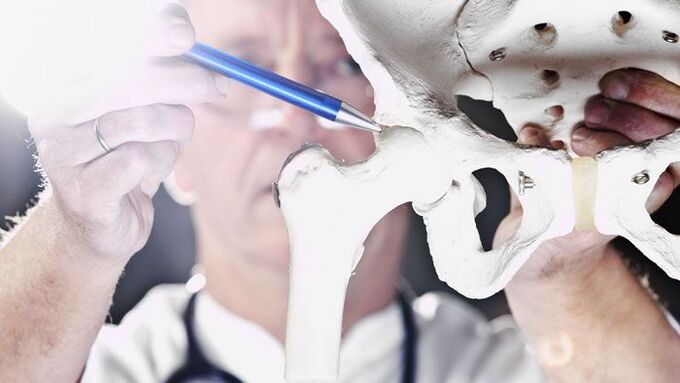
Coxarthrosis of the hip joint is accompanied by degenerative damage to the cartilage, the appearance of abnormal growths, bone resorption, inflammatory processes and other complications.
That is, this pathology is characterized by damage to the entire joint, which includes cartilage tissue, synovial layer, subchondral bone plate, muscle structures, capsule and ligaments.
The following forms of the disease are also distinguished:
- Primary coxarthrosis. It is considered the most common disease of the hip joint. In the elderly, this pathology is manifested against the background of age-related changes;
- Secondary coxarthrosis. It manifests as a result of any disease.
Causes of coxarthrosis
The development of pathology can be provoked by external, acquired and hereditary causes.
In particular, coxarthrosis can manifest itself against the background of congenital inferiority of the hip joint, degenerative-dystrophic changes, trauma, inflammatory processes, necrosis of the bone marrow of the femoral head, metabolic disorders, genetic factors, age-related changes, obesity. , vascular disorders and work in difficult conditions.
It should be noted that almost all joint structures are subject to inflammation.
3 developmental stages of coxarthrosis of the hip joint
During the development of the pathological process, the viscosity of the synovial fluid increases, which causes the appearance of microcracks and leads to drying out of the cartilage surface. This, in turn, contributes to the appearance of crunching and limited movement. A person feels such unpleasant manifestations during everyday stress and physical activity. As pressure on the lower extremities increases, the exhausted joint adapts to the strain and begins to destroy nearby structures.
Currently, the disease has 3 stages of development:
- First. Coxarthrosis of the hip joint at this stage has mild symptoms that are inconsistent and appear in the affected area. At the same time, motor activity remains, and it is enough to take medicines to relieve pain;
- Second. When the patient is diagnosed with coxarthrosis of the hip joint in the 1st stage, the disease does not cause much discomfort, but when it comes to the 2nd stage of the disease, the symptoms become more pronounced. The pain becomes more intense and begins to radiate to other parts of the body. Motor skills deteriorate significantly, which becomes especially noticeable after a long walk or increased physical effort;
- Third. If coxarthrosis of the hip joint of the 2nd degree can still be treated, in the third stage the pathology becomes chronic. It is accompanied by constant pain and spreads to the lower part of the body. The patient loses the ability to move without crutches. In the absence of appropriate therapeutic measures, cartilage and muscle structures atrophy.
Types of coxarthrosis
The classification of the pathology of the hip joint is based on one criterion - how the disease developed in the musculoskeletal system. Two main risk factors can trigger the development of the disease - genetic and acquired due to age-related changes. The pathological process is divided into several types, depending on the source of occurrence:
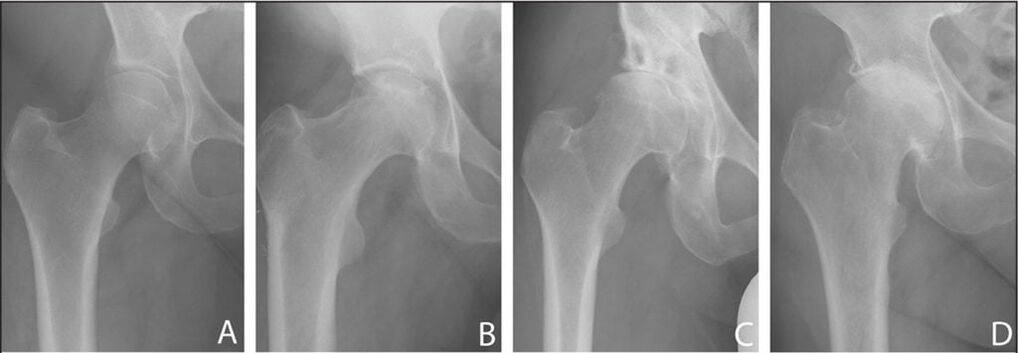
- Primary coxarthrosis. This pathology manifests itself in the hip area and is acquired. In the initial stage, it affects the synovial capsule, and then passes into the area of the tissues surrounding the joint. Risk factors include increased pressure on the pelvic bones, excessive physical activity, and the presence of inflammatory foci in the lower limbs and spine. Degenerative changes are concentrated in tissues that have already changed;
- Secondary coxarthrosis. This anomaly is hereditary. It manifests itself in the joints and the musculoskeletal system. The development of the pathological process can begin already in the womb after a woman suffers an injury, as well as against the background of necrosis of the bone marrow of the femoral head.
Types of occurrence of coxarthrosis:
- Post infection. Identified in the presence of consequences after infectious diseases;
- Post-traumatic. It is diagnosed in case of complications after a limb injury;
- Dyhormonal. It occurs against the background of metabolic disorders or drug overdose;
- Involutive. It occurs in people over 50 years old due to the aging of the body.
Diagnostic measures
If coxarthrosis of the 1st or 2nd degree of the hip joint is suspected, a full examination of the body should be performed before starting treatment. It is also important to consult an orthopedic doctor, who will perform the examination, recommend laboratory tests, and prepare an effective treatment plan. Diagnostic measures are usually limited to the following procedures:
- Radiography. It allows studying the parameters of the gap between the cartilages, diagnosing abnormal growths, and assessing the condition of the femoral head;
- Ultrasound. It makes it possible to track the etiology of changes in bone structures and ligaments, as well as study the dynamics of the patient's condition and determine the degree of development of the anomaly;
- CT. It allows you to get more detailed information about the condition of the joints and tissues located near them;
- MRI. This method provides a detailed picture of the condition of all the structures of the hip joint.
Treatment of coxarthrosis of the hip joint
If the patient has been diagnosed with 1 or 2 degree coxarthrosis of the hip joint, effective results can be achieved with conservative methods. Such therapy is prescribed to the patient individually and includes several techniques that only give a positive effect together. So, if the patient is diagnosed with 1 or 2 degree coxarthrosis of the hip joint and the corresponding symptoms are observed, the following measures can be recommended:
- use of medications;
- Physiotherapy procedures;
- Shock wave therapy;
- Physiotherapy.
In order to achieve positive dynamics with conservative methods, it is necessary to eliminate the causes that caused the occurrence of coxarthrosis of the hip joint. First of all, you need to reduce body weight, which reduces the load on the joint and minimizes the likelihood of further development of the degenerative-dystrophic process.
You should also stop using tobacco products and increase physical activity, avoiding overexertion. In order to prevent the progression of the pathology, experts recommend the use of orthopedic devices (ortheses and bandages). They enable the joint to be firmly fixed and provide the necessary support during physical activity.
Medicines
Medicines are also prescribed individually. As a general rule, patients are advised to take the following drugs:

- Nonsteroidal anti-inflammatory drugs. These drugs make it possible to achieve a double effect: they relieve pain and eliminate the inflammatory process;
- Preparations containing chondroitin, glucosamine and collagen. They enable the activation of restoration processes in the cartilage;
- Steroid hormones. Drugs with a strong anti-inflammatory effect. It is used in situations where NSAIDs are ineffective;
- Muscle relaxants. Medicines that relieve muscle tone, which is a necessary condition for relieving pain of increased intensity;
- Means for normalizing blood circulationand improving the trophism of tissues located near the joint;
- Vitamin B. Complexes containing this vitamin are prescribed to improve nerve transmission, which is especially important when the endings are compressed by the affected structures.
In case of significant intensity of pain, periarticular blockades are also recommended. They are only performed under the supervision of professionals in a clinical setting. In this case, special solutions containing steroid hormones and anesthetics are injected into the joint.
Gymnastics for coxarthrosis of the hip joint
Special exercises recommended for coxarthrosis of the hip joint are particularly effective in restoring motor functions and reducing muscle spasm. Thanks to the optimally chosen load, it is possible to relieve pain and increase the amplitude of movements. In addition, a properly assembled complex allows you to prevent atrophic processes in the muscles and relieves spasms if pinched nerve endings are observed against the background of the disease.

In addition, gymnastics for coxarthrosis of the hip joint helps improve blood flow in the affected area and allows you to speed up the recovery process.
When choosing exercises, the specialist must take into account the destruction of the hip joint and the physical condition of the patient.
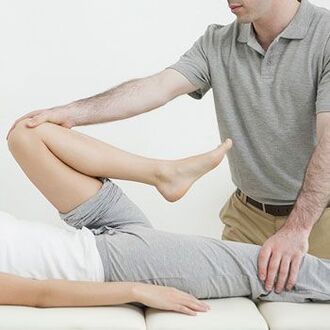
Physiotherapy methods
Massage treatments and physical therapy can provide special pain-relieving, anti-inflammatory and anti-inflammatory effects. In addition, they help maintain the muscle tone of the limbs, preventing atrophic processes.
In the case of disorders of the hip joint, the following procedures are performed:
- UHF;
- Laser exposure;
- Ultrasonic treatment;
- Magnetotherapy;
- Exposure to direct current in combination with drugs;
- Paraffin therapy;
- Phonophoresis.
The above treatment provides a positive effect only if the patient has been diagnosed with coxarthrosis in the primary stage.
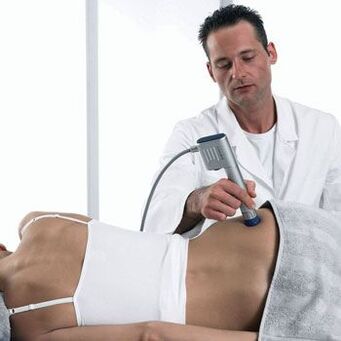
Shock wave therapy for coxarthrosis
In coxarthrosis of the first or second stage, shock wave treatment provides significant positive dynamics. For example, a 10-15 shock wave therapy procedure can reduce the negative manifestations characteristic of stage 2 pathology to signs of the initial stage of the disease.
It is important to understand that only timely treatments provide the best healing effect. At the same time, it is possible to reduce the number of SWT procedures.
However, when affecting the affected joint with shock waves, the most important positive aspect is the ability to normalize blood circulation, which promotes the accelerated supply of important nutrients involved in regeneration processes to the various structures of the hip joint.
In addition, as part of the implementation of shock wave therapy, it is possible to crush abnormal bone growths, which contribute to significant irritation of joint tissues and prevent regeneration.
The clinics are staffed by physiotherapists and neurologists with professional experience. They work fluently with the latest physiotherapy methods, including the shock wave method. In addition, professionals are able to work with modern equipment. This ensures a guaranteed positive effect and makes it possible to shorten the treatment period.
Surgery
Unfortunately, many patients delay joining a health care facility and turn to a specialist only when irreversible processes begin in the hip joint.
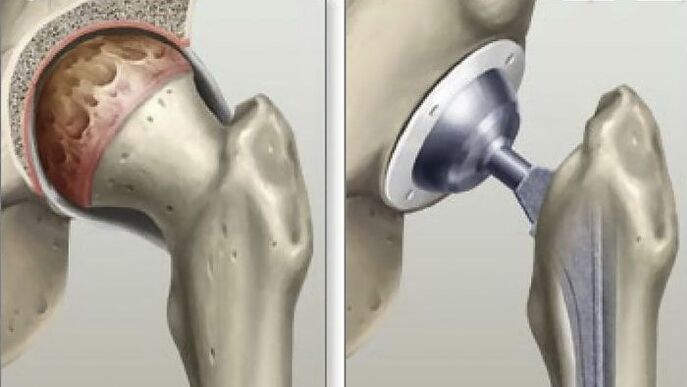
In the advanced third or fourth stage of the disease, the only effective method is surgery. It restores motor skills and eliminates acute pain, i. e. significantly improves the patient's quality of life.
Surgery is usually prescribed in the following cases:
- Painful sensations of increased intensity that cannot be relieved by medication;
- Absence of the interarticular space;
- Violation of the integrity of the femoral neck;
- Significant limitation of physical activity.
Taking into account the intensity of joint damage and changes in bone tissue, patients may be prescribed the following types of interventions:
- Arthrodesis. An intervention that creates complete immobility of the joint. Special metal plates are used for this purpose;
- Osteotomy. A surgical procedure consisting of an artificial fracture of the femur to straighten the shaft. The resulting parts are placed in the most optimal position, which allows removing excessive load from the affected joint;
- Arthroplasty. The only method by which all the functions of the hip joint can be restored and the patient can be completely cured. After using this method of eliminating coxarthrosis, a person forgets about joint problems for 20-30 years.
Medical centers perform surgical interventions in the area of the hip joint of any complexity. They are performed by highly qualified specialists using modern tools and technology, which eliminates possible errors during the intervention.
Complications of the disease
When the pathological process is in an advanced stage, the mobility of the joints is significantly limited, the person loses the ability to walk and care, and abnormal tissue fusion is observed. In addition, such an anomaly can have an undesirable effect on walking, caused by the appearance of lameness and a decrease in the size of the limb.
Preventive measures
Patients with hip pain should be monitored by a specialist and use special orthopedic devices during work and physical activity. In addition, x-rays should be taken three times a year after surgery to check the condition of the joint.


















































